Intermarkets' Privacy Policy
Donate to Ace of Spades HQ!
aceofspadeshq at gee mail.com
Buck:
buck.throckmorton at protonmail.com
CBD:
cbd at cutjibnewsletter.com
joe mannix:
mannix2024 at proton.me
MisHum:
petmorons at gee mail.com
J.J. Sefton:
sefton at cutjibnewsletter.com
No Shock: Tech Company Offers $60/Hour Coding Job with Proviso: "No US Citizens" May Apply
Jasmine Ratchet Makes It Official: She's Running to Win the Primary to Lose the Election for Texas Senator
The Morning Rant
Mid-Morning Art Thread
The Morning Report — 12/9/25
Daily Tech News 9 December 2025
Monday Overnight Open Thread (12/8/25)
Monday Cafe
Supreme Court Seems Likely To Rule That the President Has Control Over, Get This, the Exectutive Branch
Jim Sunk New Dawn 2025
Jewells45 2025
Bandersnatch 2024
GnuBreed 2024
Captain Hate 2023
moon_over_vermont 2023
westminsterdogshow 2023
Ann Wilson(Empire1) 2022
Dave In Texas 2022
Jesse in D.C. 2022
OregonMuse 2022
redc1c4 2021
Tami 2021
Chavez the Hugo 2020
Ibguy 2020
Rickl 2019
Joffen 2014
maildrop62 at proton dot me
TBD
Saturday Gardening and Puttering Thread, December 5, 2020 [KT]
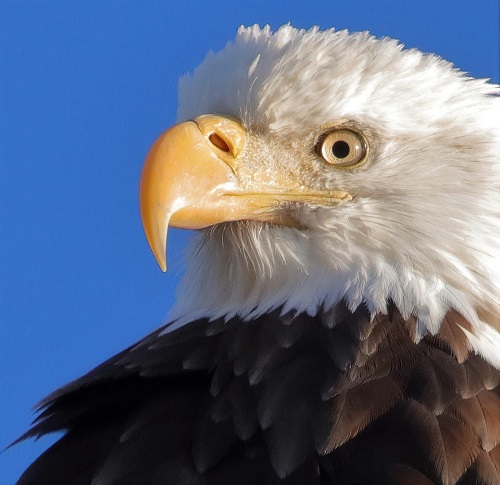
Hi, everybody! Isn't the shot above amazing?
I thought I'd send in this snap I got of a Bald Eagle. The eagle was perched at the top of a fir tree, and I cropped this image from that shot. Lizabth
Thanks!
I love it, Lizabth. I think others will, too!
Today, we have some American Farm History and a Vegetable Profile with some recipes. And some special composting directions to help you grow some great veggies (or other plants).
It's still catalog season. You may be able to get some gift ideas. If you're not out in the Great Outdoors like Lizabth, take a little time to dream.
American Farm History
Why is there a statue honoring the boll weevil in Enterprise, Alabama?
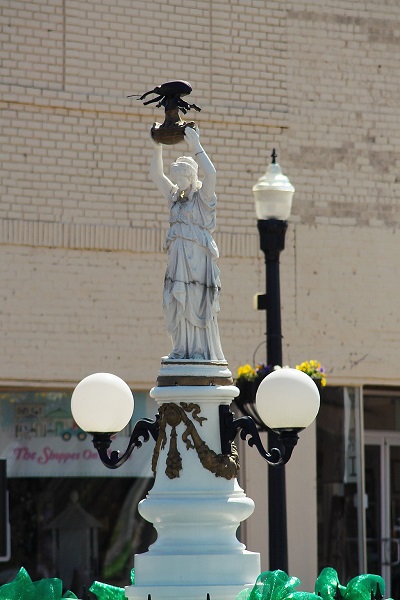
"I cannot think of another insect that's displaced so many people, changed the economy of rural America, and was so environmentally injurious that everybody clearly rallied around and said we have to get rid of it," says Dominic Reisig, a professor of entomology at North Carolina State University.The havoc the boll weevil wrought on the Southern economy was so disruptive that some scholars argue it was one of the factors that spurred the Great Migration--the movement of 6 million African-Americans from the South to urban areas in the North. As the weevil destroyed cotton farms, many farmworkers moved elsewhere for employment, including urban centers.
So why would any town want to honor such a pest with an expensive statue, let alone call it a herald of prosperity? To understand that requires jumping back over 100 years in history, to when the insect first invaded American farmland.
What happened in Enterprise:
H.M. Sessions, a man who lived in town and acted as a seed broker to farmers in need, saw the devastation and knew he needed to act.Farmers could switch to other crops that wouldn't support the boll weevil, but cotton generated the highest profits and grew on marginal land--"sandy, well-drained land that not a lot of crops can tolerate," Reisig explains. One of the few crops that could tolerate those conditions: peanuts. After visiting North Carolina and Virginia, where he saw peanuts being grown, Sessions came back with peanut seeds and sold them to area farmer C. W. Baston.
"In 1916, Mr. Baston planted his entire crop in peanuts. That year, he earned $8,000 from his new crop, and paid off his prior years of debt and still had money left over," Bradley says.
Since peanuts replaced cotton in Enterprise, the boll weevil has been brought under control in many places through the use of pheromone traps.
Heard of Pima cotton? Cotton was grown by the Pima Indians in the olden days, then cultivation was dropped. Six seeds remained, and the strain was revived. But that is not the strain we call "Pima cotton" today. It came from a USDA station near the Pima reservation. Unrelated. Interesting.
Around here, Acala (upland) cotton is grown. Here's a comparison of Pima and Upland cotton. It's against the law to grow other kinds of cotton locally, say, in gardens.
Cotton for Gardeners
There is a related species, black cotton. The leaves are dark. The cotton is white. Quality of the cotton is probably not as high as that of Pima cotton. The opening flowers are the most attractive thing about the plant, I think.
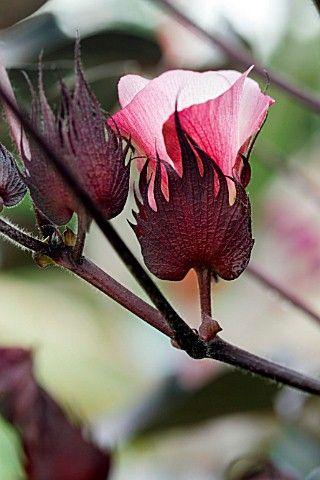
Putterers might be able to use the dried pods and cotton for crafts, something like the ones below, made with regular white cotton (burrs as ears) and dried okra pods as hats. The genomes of five species of cotton have recently been sequenced. Cotton is big business.
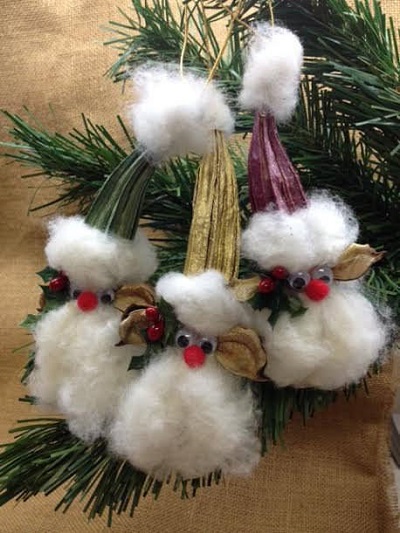
One of several cotton pests that is still with us is the Red Cotton Bug. Also known as the Cotton Stainer or Okra Bug. Nymph seen here on Okra. This bug also attacks Hibiscus. I've never seen one.
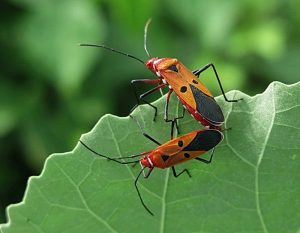
Cotton is related to okra. They are in the Mallow family, along with hibiscus, marshmallow, etc. They are less closely related to the plants that give us cocoa and kola nuts, as well as to linden trees.
Vegetable Profile - Okra
That black cotton above kind of reminds me of the red varieties of okra, like Burgundy. If that little fuzz on the pods bothers you, rub it off just before you wash the pods. And wear gloves and long sleeves when harvesting okra.
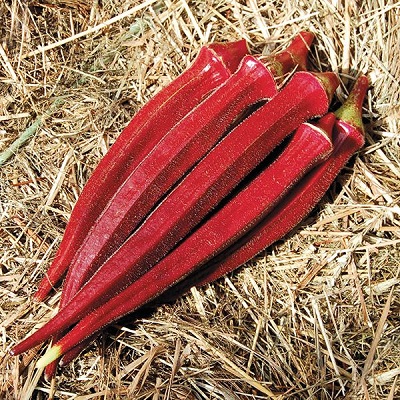
I'm a little surprised that this variety does well in Vermont. Some varieties of okra are day length sensitive. Check before choosing if you live in the North. You can start Okra indoors if you live in a short-season climate.
Try picking this variety smaller than shown above, pan-frying whole, "aggressively", until crisp and dressing with roasted tomatoes and garlic.
Usually this kind of dish is a celebration of a single vegetable.
Tired of potato chips? How about some Crispy Oven Baked Okra Chips? Plain dehydrated okra rounds and Cajun-seasoned dehydrated okra snack.
If you don't want to eat okra, you can plant it for the flowers in the garden, then use it for decoration in the house. Below, a variety of pod forms. All edible when picked young, woody when allowed to mature.
And pods dolled up.
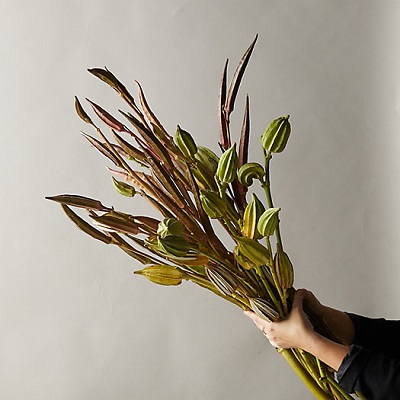
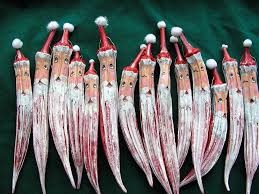
Seed Catalogs
Several people mentioned catalogs last week. We can add a few details as people comment on their favorite veggies or other plants from the catalogs.
Lizzy likes Hudson Valley Seed, for the seed packet art. Which is very interesting.
They have a Goth Garden seed packet this year. Hmmmm. It includes Dracula Celosia.
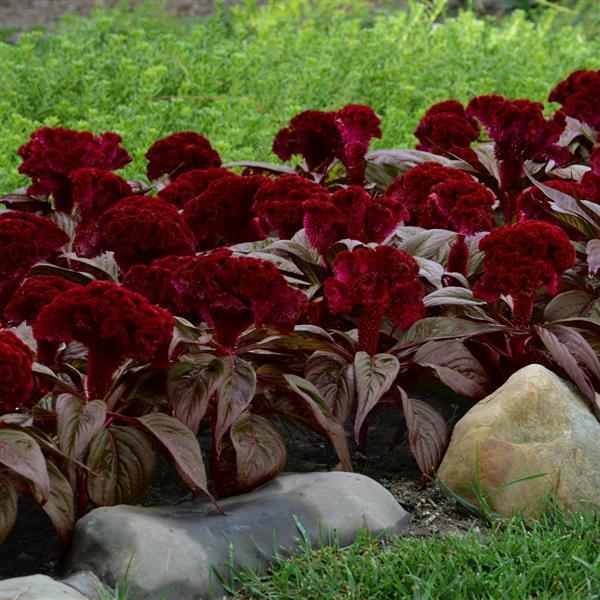
Sal likes the Whole Seed Catalog "just for fun reading materiel. I may actually buy from them for 2021."
I am not familiar with this one. Though I am familiar with Baker Creek, which puts it out. They have a LOT of fascinating stuff. Anybody have a favorite from them?
Sal also notes Southern Exposure Seed Exchange for the Southeast. They're based in Virginia, specialize in heritage plants. They sell some cotton for gardeners. Including a light brown variety.
Southern Exposure Seed Exchange has a nice "All About Okra" page. It includes history, cultivation tips and recipes. There's one for Pickled Okra. Ever thought about making "coffee" from roasted okra seeds? They say it tastes just like caffeine-free coffee. Maybe that impression has sometimes been affected by necessity - interruptions in supply of coffee, etc.
Okra has beautiful flowers. You can see the resemblance to Hibiscus, Rose of Sharon and Hollyhocks.
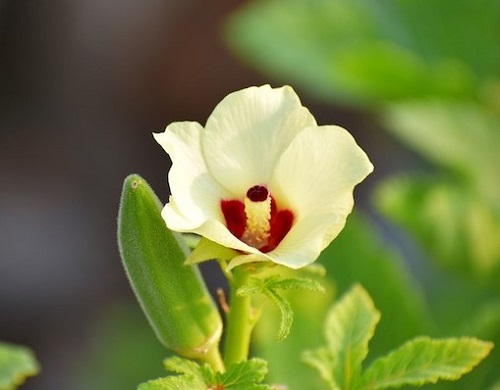
They also sell 21 kinds of okra and a book about okra.
Twilley's may sell 51 kinds of pumpkins, but Southern Exposure sells 66 varieties of greens! Garden huckleberries. And some flowers. Eight kinds of marigolds. They seem to like French marigolds best.
You might recall that I said last week that 'Dainty Marietta' (Crosman Seed Co.) was hard to find. This is 'Naughty Marietta'.
Old fashioned marigold. Golden-yellow single flowers with splashes of mahogany. 10-in. plants. (Similar to "Dainty Marietta," but somehow "Naughty Marietta" gets more attention...)
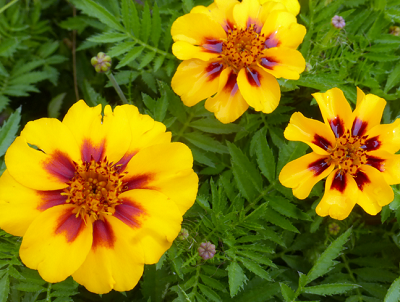
Tashkent:
[Found outside an old Muslim school in Tashkent, Uzbekistan in 1992. A favorite of flower seed collector Bob Bell. Introduced 1999 by SESE.] 78 days. 24-30 in. tall plants with a sweet marigold fragrance. Lacks the common astringent odor of other marigolds. The plants are so fragrant they sweeten the air on a hot summer day. Bears numerous 1 1/2 -2 in. single petalled flowers that have yellow centers and velvet mahogany petals, with a fine orange border. Petals change from mahogany-red to orange-red as they mature. One of our favorites.
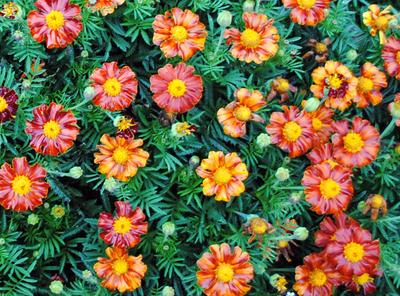
Ronster remembers Gurneys. I remember them as having a slightly tabloid vibe in the past. They seem a little more corporate now. They have started offering a few interspecies stone fruit trees. Some of them still seem like a bit of a gamble to me, depending on your climate. This is the Honey Pearls Nectacot:
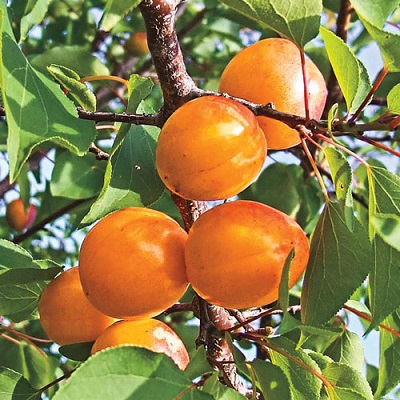
Flyover got a catalog from the socialists at Fedco. They are less annoying than some socialists. Catalog is aimed at market growers and shipping costs are high for small orders. You may be tempted to by large packets of seeds.
One advantage of the Fedco catalog is that they give you good information on how long it takes to get its varieties to maturity. They are in New Englands, in a short-season area.
I have been tempted by the Rose de Berne tomato. The "Brandywine of continental Europe". I have grown some 'Cosmonaut Volkov' tomatoes from their seed that were so good they made your eyes roll back in your head. Didn't last all season in our heat, though.
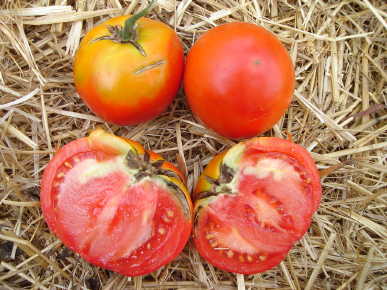
Pat* recommends Territorial Seed Company. It is very informative, especially if you live in the PNW.
Here's something different: A little hardy kiwi that doesn't need a pollinator, on a vine that isn't too rampant. Doesn't say if it attracts cats. Prolific is its name.
Special Tutorial on Making Compost
How to Make (Lots of) Compost: the Very Basic Version
-by The Famous Pat* and Pat*'s Hubby
This recipe is meant for larger properties, it's not for just dealing with kitchen waste. We recommend having the following items available:
Grass
Leaves
Water
Wire cages
Pitchfork
A good amount of room
Patience
First, find spots where you can put two different series of wire cages, one for leaves and one for compost. The compost cages should be located where you can get water to them if you live in dry country. Our cages are 3 feet tall, 4 to 5 feet across or so, made from fence wire (holes are 2 inches by 4 inches), wired into a circle. Some stuff will fall out the sides - just pick it up and throw it back in later.We started in the fall, by collecting compostable leaves - leaves that don't have waxy coatings, that are generally smaller, or easy to shred. In our experience, maple, linden, sweet gum, apple, and crabapple work well. Oak (waxy coating) and sycamore (just won't shred) do not work. You may have to experiment to find out what leaves on your property will work best. If you have a shredder, shred the leaves before putting them into the leaf cages - they'll take up less room and break down faster.
Pile the leaves into the leaf cages. Wait for the grass to grow.
When you mow the grass, collect the excess clippings, either with a bagger, or using a sweeper after mowing (we use a Brinley model for that, and for gathering some of the leaves). Throw some saved leaves at the bottom of your first compost cage, then some grass. Alternate. Mix things up with the pitchfork - and don't let the grass clump up, mix it in while it's freshly cut if you possibly can. You can also throw in fruit and veggie waste from the kitchen and garden, crushed eggshells, and paper coffee filters with grounds. We avoid meat scraps, sticks, weeds, fibrous plant stems or rinds, and any plant material that has had a disease or pest problem. Continue adding material until a cage is full.The pile will need some water in order to turn into compost. You don't want the pile to be dry, or no breakdown will happen. But you don't want it sopping wet, either. If you are in an area with regular rainfall, just try it and see what happens. If you are in arid country, like the southwest or the intermountain West (where we live), you'll need to help it out. We use mini-sprayers attached to drip irrigation tubing to dampen the pile - they're wired onto the top of each compost cage, and they run whenever the garden drippers run.
Once cage 1 is full, use the pitchfork to turn the material from cage 1 into cage 2. Start filling cage 1 again.
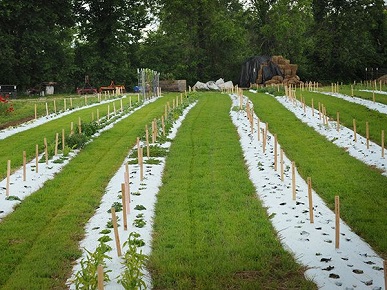
When cage 1 is full once again, cage 2 is turned over into cage 3 - and cage 1 is turned over into cage 2 - and cage 1 starts filling again. Continue this process with as many cages as you like. The turning process is how we aerate our compost. As we get closer to finished compost, I try to break up any clumps as I go. I have a pair of garden gloves that I wear just for working with compost, so I can do the breaking-up by hand.Our yard has a series of 4 compost cages. It takes 2 years or more for the starting material to become good compost. We're using our compost to turn a chunk of paddock (originally made of just clay and sand) into a good corn-growing bed. I dump the final, fully composted material into the expanding corn bed, and Husband tills it in, each spring.
One lesson I learned the hard way: you may get plants growing in the compost. One year we had a huge number of tomato plants growing out of the top of a cage. I let them grow, though Husband told me not to. But I regretted not listening to him! When I tried to turn the compost later, the roots were everywhere, and made the work much harder than it needed to be. So if plants grow in the compost, either transplant them, or pull them out! (Pull weeds out ASAP - don't let weed seeds get in the compost.)
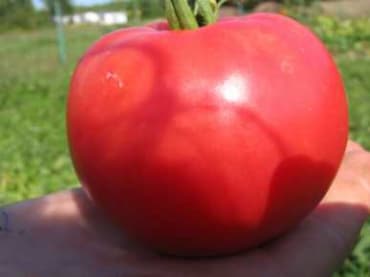
(not in a compost cage)
If you don't have a lot of room - or if you don't have a lot of need for compost for soil improvement - you could create just one leaf cage and one compost cage. Fill the leaf cage half full. If you mix grass and leaves in the compost cage, until the compost cage is full, the leaf cage should be empty. You can then turn the compost from one cage to the other - I'd say about twice a year, in spring and fall - until you have compost that looks like soil. *****
Thanks, Pat* and Hubby! We are impressed!
If you would like to send information and/or photos for the Saturday Gardening Thread, the address is:
ktinthegarden
at that g mail dot com place
Include your nic unless you want to remain a lurker.
18-1: "One point to ponder - the people the left appoints ..."
whig: "266 Things will change when The Blade starts as an ..."
Thomas Bender: "@259 >>Never get work done at a dealership, the ..."
Chuck Martel: "They hate us. And I'm including both Dems and Repu ..."
Boss Moss: "I found a repetuable mechanic. No bullshit on stat ..."
whig: "McDonald’s Netherlands has managed to do the ..."
Paco: "[i]Things will change when The Blade starts as an ..."
Eromero: " I was on Joint Base Lewis McChord yesterday (I w ..."
TheJamesMadison, seeing life through the shadows with Otto Preminger: "257 Laying the predicate is an important step in e ..."
runner: "who is keeping an eye on the clowns in Congress?? ..."
Black JEM: "EEOC is starting to go after the Indian tech compa ..."
No Shock: Tech Company Offers $60/Hour Coding Job with Proviso: "No US Citizens" May Apply
Jasmine Ratchet Makes It Official: She's Running to Win the Primary to Lose the Election for Texas Senator
The Morning Rant
Mid-Morning Art Thread
The Morning Report — 12/9/25
Daily Tech News 9 December 2025
Monday Overnight Open Thread (12/8/25)
Monday Cafe
Supreme Court Seems Likely To Rule That the President Has Control Over, Get This, the Exectutive Branch
Paul Anka Haiku Contest Announcement
Integrity SAT's: Entrance Exam for Paul Anka's Band
AllahPundit's Paul Anka 45's Collection
AnkaPundit: Paul Anka Takes Over the Site for a Weekend (Continues through to Monday's postings)
George Bush Slices Don Rumsfeld Like an F*ckin' Hammer
Democratic Forays into Erotica
New Shows On Gore's DNC/MTV Network
Nicknames for Potatoes, By People Who Really Hate Potatoes
Star Wars Euphemisms for Self-Abuse
Signs You're at an Iraqi "Wedding Party"
Signs Your Clown Has Gone Bad
Signs That You, Geroge Michael, Should Probably Just Give It Up
Signs of Hip-Hop Influence on John Kerry
NYT Headlines Spinning Bush's Jobs Boom
Things People Are More Likely to Say Than "Did You Hear What Al Franken Said Yesterday?"
Signs that Paul Krugman Has Lost His Frickin' Mind
All-Time Best NBA Players, According to Senator Robert Byrd
Other Bad Things About the Jews, According to the Koran
Signs That David Letterman Just Doesn't Care Anymore
Examples of Bob Kerrey's Insufferable Racial Jackassery
Signs Andy Rooney Is Going Senile
Other Judgments Dick Clarke Made About Condi Rice Based on Her Appearance
Collective Names for Groups of People
John Kerry's Other Vietnam Super-Pets
Cool Things About the XM8 Assault Rifle
Media-Approved Facts About the Democrat Spy
Changes to Make Christianity More "Inclusive"
Secret John Kerry Senatorial Accomplishments
John Edwards Campaign Excuses
John Kerry Pick-Up Lines
Changes Liberal Senator George Michell Will Make at Disney
Torments in Dog-Hell
The Ace of Spades HQ Sex-for-Money Skankathon
A D&D Guide to the Democratic Candidates
Margaret Cho: Just Not Funny
More Margaret Cho Abuse
Margaret Cho: Still Not Funny
Iraqi Prisoner Claims He Was Raped... By Woman
Wonkette Announces "Morning Zoo" Format
John Kerry's "Plan" Causes Surrender of Moqtada al-Sadr's Militia
World Muslim Leaders Apologize for Nick Berg's Beheading
Michael Moore Goes on Lunchtime Manhattan Death-Spree
Milestone: Oliver Willis Posts 400th "Fake News Article" Referencing Britney Spears
Liberal Economists Rue a "New Decade of Greed"
Artificial Insouciance: Maureen Dowd's Word Processor Revolts Against Her Numbing Imbecility
Intelligence Officials Eye Blogs for Tips
They Done Found Us Out, Cletus: Intrepid Internet Detective Figures Out Our Master Plan
Shock: Josh Marshall Almost Mentions Sarin Discovery in Iraq
Leather-Clad Biker Freaks Terrorize Australian Town
When Clinton Was President, Torture Was Cool
What Wonkette Means When She Explains What Tina Brown Means
Wonkette's Stand-Up Act
Wankette HQ Gay-Rumors Du Jour
Here's What's Bugging Me: Goose and Slider
My Own Micah Wright Style Confession of Dishonesty
Outraged "Conservatives" React to the FMA
An On-Line Impression of Dennis Miller Having Sex with a Kodiak Bear
The Story the Rightwing Media Refuses to Report!
Our Lunch with David "Glengarry Glen Ross" Mamet
The House of Love: Paul Krugman
A Michael Moore Mystery (TM)
The Dowd-O-Matic!
Liberal Consistency and Other Myths
Kepler's Laws of Liberal Media Bias
John Kerry-- The Splunge! Candidate
"Divisive" Politics & "Attacks on Patriotism" (very long)
The Donkey ("The Raven" parody)

